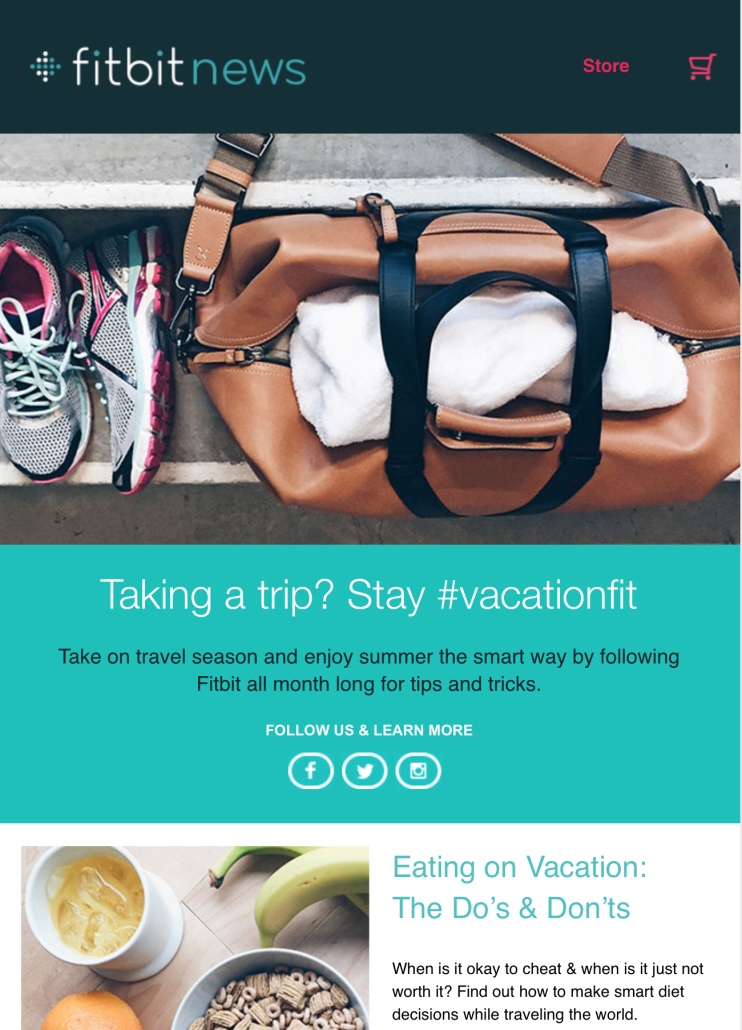Developing Content Your B2C Users Actually Want
“I know a guy for that.”
“We’re going to do content marketing. I know somebody who is gonna do that for us.” It surprises me how often I hear this line from founders in our program. “You’re just gonna get someone to do that?” I say. “Yeah, you know, somebody will do some content. Some blog posts, a newsletter, part time.” “Okay… and what will they be about?” “Oh, you know, about the product and you know, stuff in that area.”
As we often say, it’s much easier to teach an engineer something about marketing, than it is to teach a marketer something about engineering. We’re exposed to marketing, particularly content marketing, pretty much every day. You get email updates from services you’ve signed up for, or you click on links that friends have shared on Facebook. So we naturally assume that we understand the behavioral economics of content marketing pretty well.
And it’s become such second nature to also assume it must be easy- something you can just assign to somebody on a part-time basis. Set it and forget it.
But we also tend to assume that we are immune to its effects, while it’s really aimed at that mass of people out there who we deem “typical,” or “average.” Certainly I don’t shape my habits and thoughts around cues that are generated externally. I can’t be manipulated- that’s something that happens to other people.
On the one hand, our founders deeply understand their own products, and the importance of those products as experiences for their users, but they will also tend to discount the marketing around those products as a factor in that experience. As I’ve said often, marketing is not something to be “handled-” it is half of the product/market fit equation.
I would say that I hear some version of: “we will get someone to handle that marketing stuff.” From about half the startups we work with, at the beginning. I’ve come up with a the best answer I can to this refrain: “Yeah… it will be you.” And by the end of the program, most founders are devoting more energy to the marketing challenges they face, than to the development challenges they thought were more important when they started.
What Marketing Accomplishes
Founders commonly understand that marketing is about communicating the existence and benefits of their products. But that’s sort of like saying that the purpose of a car is to keep four tires in contact with the ground. It is something a car has to do- it is one way of defining a car, but it’s not the real purpose.
Instead, marketing is really about helping people to do things that they will want to do. Now, a person may not *know* that they want your product -because they may not know your product even exists yet- so your marketing has to start there. But it can’t end there. Instead, announcing that your product exists, or as in the worst cases of pointless email marketing, still exists, is just the beginning.
As with a car, whose purpose is to get people where they want to go, the purpose of marketing is to get people to do what they already want to do, or need to do- it is to eliminate reasons and barriers against using your products.
Content Marketing: The Why
As we know, there are a lot of ways that marketing can be used to diminish, eliminate, and circumvent barriers. Not sure if you want to pay? Take a trial. Not sure it’s worth the money? Have a discount. Does it do everything you need? Check the features page and the FAQ. These are the basics, and they help us to erode the gap between the decision to use and commit to a product, and the decision to pay for it. By the time people pay for our product- we want them to want to be paying for it.
And we want them to continue to want to pay for it. It costs 10 times as much to obtain a new customer, as it does to retain an old one. And that’s why, particularly in a B2C SaaS business where customer churn is naturally high, the most important metric you can focus on once you have any real number of paying customers, is how many stay with your products and continue paying for them for any length of time. Keep improving that number, and you’re unlikely to fail.
Many startups start off viewing their marketing as a funnel that leads to, and ends with, a purchase. That’s sometimes a fatal error, particularly if your growth model depends on repeat business. Many startups spend much more time, money, and energy on customer acquisition than they do on retention, even when retention accounts for much more of their revenue. Startups want to grow out, not up. They want to get bigger, but they often resist getting better.
The Who: Different Users Have Different Needs
Consider some numbers for a moment. And I’ll base this on a fictionalized version of a real company i worked with a while back. It was a mobile app and web platform.
The company had about 1M app downloads, and about 80,000 monthly active users. For active users, the product was incredibly sticky, with the average user accessing the app at least 3 times a week. Of the 80,000 monthly actives, about 5,000 were paying for a premium product. Again, the product was incredibly sticky, and had been around for a while, so it had a core user group that was really hooked. so churn for paying users was really low.
Here’s where the math comes in. At €2 a month for premium, the company would be bringing in about €10,000 a month in revenue for the premium product. However, the churn for the premium product was 20% (which is still really great). This meant that the product needed to attract at least 1000 new paying users a month to keep its revenue at the same level.
But when we looked at the churn for users who were new to the premium product, turnover was much higher- up to 60% for the first three months after the user purchased premium, before it fell off and the product stuck.
So the company was only keeping about 40% of its incoming premium users for more than 3 months, at which point the >3 month churn rate was about the same for all users.
But the company was treating their marketing as if it existed in two tranches: paying and non-paying users. They were assuming that they would have to recruit at least 1000 new paying users a month in order to stand completely still. Which is a lot when you only have 80,000 active users to work with.
And if you consider that only 8% of app downloads led to active use, and only 1 in 16 of those active users were willing to pay for the product so far, then you would have to gain 200,000 new app downloads a month in order to add 1000 paying users. To break even, you’d need to pay just 0.02 Euro per new app download. Maybe that’s possible, but it’s definitely not easy.
The key then, would be to focus on retention of paying customers, and on selling the premium product to more of its active users, earlier in the process.
When I talked to the company about their content marketing efforts, they said they were emailing all their active users with the same messaging- a newsletter with a few blog posts about their subject area. They were also developing a trial lifecycle email campaign for new trial users, but once someone bought the product, they were in the “already purchased” camp. There was no specific effort to engage new paying users when their churn was at the highest levels.
Worse yet, there was no specific communication targeting any paying users. Everything was focused on active users.
This is a mistake that a lot of startups make, and it’s not even always a mistake. We’re trained to view our monthly active users as our measure of success, and according to that metric, this company was doing really well with retention. They had clearly achieved some degree of fit with the free product, because a lot of people were using it a lot of the time. But the premium product wasn’t taking off in the same way.
They hadn’t achieved market fit with the paid product. So their answer to that problem was to develop the premium product with more features (another issue we can talk about in another post) But just because you’re having trouble selling a premium product, doesn’t necessarily mean the product is not worth paying for.
Sometimes, users who are paying for it just don’t know what they’re getting. And users who aren’t paying for it may not know what they’re missing. That’s an experience many of us have had. Who hasn’t paid for a premium product for a month or two, and been unable to name the benefits? Maybe they existed, maybe not, but we certainly don’t want to pay for something we can’t see as better than something free.
Working backward from Your Goals
This can all get very granular and very hard to deal with as a small startup. Once we start treating our marketing efforts as these very multifaceted and complex operations, it can be difficult to understand why we’re expending all the effort. And if we don’t keep an eye on the results, then it can be quite demoralizing to write great content and send it off into the ether, not knowing whether it does you any good or not.
So we encourage startups to work backwards from their marketing goals. By looking at their data and identifying a specific retention or engagement failure, they can devise ways of directly targeting that issue, and potentially fixing it. In the case above, I would encourage the startup to focus on developing engaging content for the users who have bought the product within the last 3 months. At the same time, they should put all their new users into a trial of the premium product, supported by the same content- spelling out the benefits of the premium product.
Motivational infographics, blog posts, and data about how the app is helping those users to achieve something are a good start. Specific walkthroughs and highlights of premium features can also work.
They might also launch a post-purchase retention lifecycle, including personal notes from the customer care or community team, asking for feedback and gathering survey data on the product. This helps users to feel they’re being cared for and listened to, and it can improve retention, even if you don’t act on the data you gather from them.
Whatever they do, the important point is to work backwards from a specific goal. Not “improve retention,” but “increase 3 month retention by 50%.” If you can target and execute on a goal like that, while continuing to do everything you’ve already done to gain new users, then you could potentially increase your overall retention by a huge amount, while actually growing your user base.
The How: Developing Positive Associations and Behaviors
This is all very easy to say. How is it done?
I’ve talked quite a bit in the past about how Startups should think about their marketing team. A community manager who is empowered to affect the development of the product is key. But that person also has to become an expert on the users. They have to have access to data on what the users do with the product, and with that data, they need to find ways to engage with those users to give them small, positive experiences, and reinforce the behaviors that lead them to use the app.
What does this look like? Suppose that this company had a community manager. That person should look carefully at user data, and find specific insights about specific types of users. Do certain users always use the app in the morning? Or at night? If a large group of users opens the app in the morning, then why do they do that? Is it because the app prepares them for their day?

FitBit uses location awareness to tell when you’re on a trip, and offers you content that is useful in that situation.
Try a blog post including a few tips on how else these users can make their mornings more productive. Perhaps motivational morning messages inside the app would get a good reaction. If they do, and you see the users reacting to them, then follow that pattern, and make it a positive experience that the users can expect from the product on a consistent basis. If, over a few months, that technique has been working, you can consider how else you might apply it across your whole user base.
And you don’t always have to follow user behavior in order to produce a small win with users. Perhaps there is a feature that users are not engaging with much. Try a newsletter that highlights a few of those features and their benefits, and see if the users start using them more.
In addition, use your knowledge of your users to generate data that may be interesting to them. If your app saves people time for example, employ that data in a post about how much time you’ve been saving your premium users, and exactly how that has been working. Whatever your app does that is a benefit to its users, highlight that in real terms.
Form is Function
We tend to get locked into one type of content marketing over time. For me, it’s always blog posts, because that’s what I like to do. I enjoy writing, and I enjoy the structure. But even StartupYard does other forms of content marketing, despite the fact that we don’t have an app to promote or a service that applies to more than a handful of people.
Content marketing can take many, many forms. Aside from the “traditional” types of content like blogs, email, videos, infographics, and other static content, you can also generate user specific content that can serve to reinforce positive behaviors and feelings with each user. We often call this “gamification,” even when it really isn’t that. It’s just content that reinforces positive behaviors.
For example, I used FitBit for over a year, until my FitBit recently stopped working. FitBit, if you don’t know, is a fitness tracker that sits on your wrist, and lets you know how many steps you’ve taken throughout the day. Mine stopped working, but I plan to replace it, and keep using the service.
Here’s why: every day, usually in the evening, I would take a look at my stats, and find that more often than not, I had not completed my “step goal” for the day, which was around 15,000 steps. So almost every night, after we put our son to bed, I would go out for a walk to “make up” my steps.
Over the course of a week, I would look at my stats to see whether I was meeting my weekly goals. At the basic level, this is a form of content marketing. It is employing user data in order to reinforce certain behaviors. It doesn’t scream: “USE ME!” Instead, it gently reminds the user of the best way to use the product.
Internal, and External Content Marketing
As the above shows, content marketing is not defined by click-bait articles on mashable that get users to download something new and cool. You can use content marketing to recruit new users, but you should also be using it to engage with the users you already have.
Again, StartupYard practices both kinds of content marketing- with the dual goals of engaging with new people like potential mentors, investors, or applicants to our accelerator program, but also engaging with and improving our relationship with our existing companies, mentors, and investors.
Recently, for example, we emailed all of our mentors, asking them to fill out a short survey. It took about 5 minutes. The response rate was nearly 50%. While many of the mentors were probably not consciously aware of it, the survey served two simultaneous goals. It allowed us to get insights into what our mentors think about us, what they want from us, and what they want to get out of mentoring. But it also subtly reinforced certain behaviors that we want our mentors to have.
For example, we asked mentors whether they had “personally connected” a startup to at least one of their contacts. 100% of the responding group had done so. But when we asked the mentors whether they had “personally connected” one of our startups to an investor, only 50% of them had done so.
The question is aimed at gathering valuable information for us, but the survey was also anonymous. We can’t judge specific mentors, or their worth, based on what connections they have provided for our startups. However, that this question was asked in exactly the same way as the previous question, reinforced to our mentors that providing connections to investors is something StartupYard hopes our mentors will be able to do.
A mentor who answered “no,” may then think about whether they have been trying as hard as they can when it comes to mentoring. Perhaps they mentioned an investor, but did not make a personal connection for the startup. Perhaps they talked to the investor, but didn’t then follow up with the startup to see whether the connection had really been made. In sum, the mentor may act differently the next time, and may try a little harder.
The survey was full of these types of questions- it reminded mentors of events that StartupYard holds for mentors, and checked to see if they had attended our demo day. It asked our mentors to rate the progress of our startups, but it combined those sorts of questions with subtle cues about how active the mentors themselves have been. A mentor that rates our startups’ progress as middling, but who indicates that they haven’t been to any of our events or the demo day, may turn the question on themselves: “have I done enough here? Do I have a right to this opinion?”
This is not manipulation. As I’ve said often, and as I always stress with our startups: you cannot make people do things they wouldn’t normally do. But you can help people to see how valuable they are, how included they are, and how they can make a difference for themselves or for others. You can show people what positive results look like, and content marketing, whatever its form, has to follow that function above all others: it has to make people aware that life is better with you, than without you.







